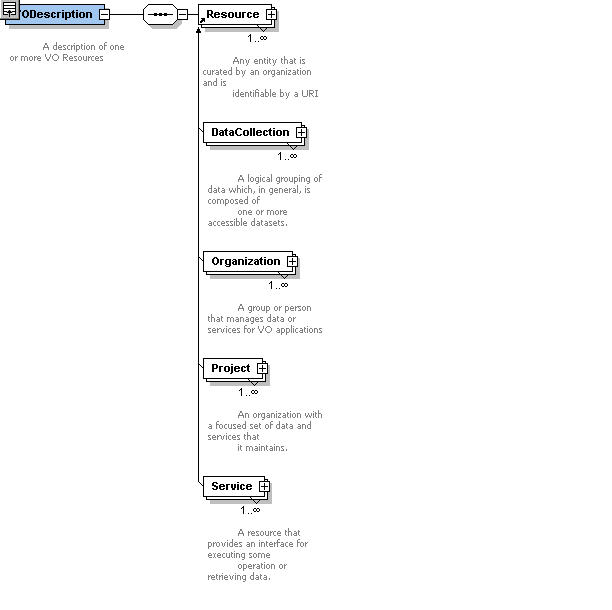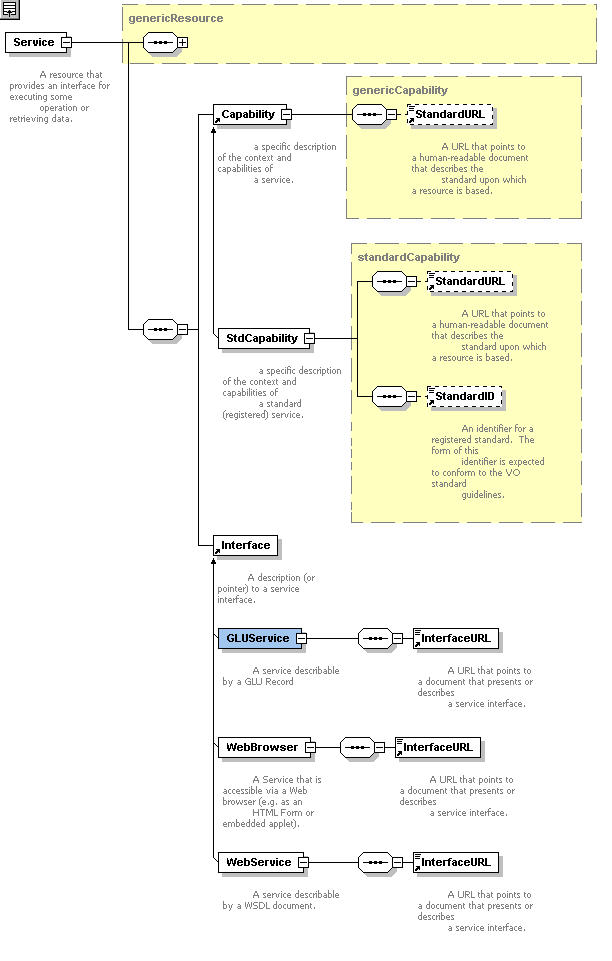
| Registry Working Group | |||
| Links: | Registry Twiki | Registry Mail Archive | IVOA Members |

|
|
||||||||||||
| International Virtual Observatory Alliance | |||||||||||||
Resource element.
Figure 2 illustrates the structure of this
metadata; the yellow box (representing a genericResource
type) encloses the common Resource metadata. In includes three main
catagories: Curation, Content, and
Coverage.
 Figure 1: The different types of Resources |
 Figure 2: Generic Resource and Service Metadata
|
The second principle recognizes that different types of resources
require addition metadata to describe that is not common to the other
types. This schema provides a way to "hook" on this extra metadata
using a combination of XML type extension and XML substitution groups
(see section 2.2 below). In a real sense, the
Organization, Project, DataCollection,
and Service elements inherit
from the generic Resource. Resources that don't match one of these
"sub-elements" could be described by the generic
Resource element, or additional sub-elements
could be defined to accommodate. The arrows in Figures
1 and 2
indicate that a sub-element can be substituted in anywhere that a
Resource is expected. The
VODescription element is provided to
allow a listing of Resources of different types.
The Service element extends
Resource to add two additional child
elements: Capability and
Interface (see Figure 3).

Figure 3. Generic Service Metadata.
The Interface element is an extension
point for describing different types of interfaces, such as Web
browser-driven forms (WebBrowser) and
Web Services (WebService). The
WebService simply provides a place,
InterfaceURL to point to a WSDL
document.
The Capability element is place to place
all metadata that does not fit well into the interface description.
The StdCapability sub-element is meant
for describing standard services such a Simple Image Access or Cone
Search. This is described below.
1.2 Support for Simple Image Access Protocol
The metadata specific to Simple Image Access has been separated into
another schema, VOStdService. The
SIA's interface is described with a
ParamHTTPGet element (a sub-element of
Interface); this holds the supported
input parameters, the BaseURL, and the
MIME type of the output (see Figure 4).
The SIA specification defines a special set of metadata which are
interpreted here as part of its "Capability". In this schema, the
StdCapability is extended to produce the
SimpleImageAccess to hold that metadata,
as shown in Figure 5. The
VOTableColumns element is meant to list
the VOTable Field tags that describe the
VOTable output columns. In both figures below, the "vot"
namespace prefix indicates elements borrowed from the VOTable schema.
 Figure 4. SIA Interface represented as a ParamHTTPGet element.
|
 Figure 5. Simple Image Access and related metadata.
|
I note that the separation between VOService and VOStdService is not
as clean as it should be. (The separation was mainly guided by
experimentation and debugging needs.) The
ParamHTTPGet should be moved to
VOResource as one of general service interface types. Furthermore,
VOStdService should be specialized (at least in name) to just SIA.
Other standard services should have their specific metadata in their
own separate XML Schema documents.
1.3 Sample XML Document
The example, adil.xml, uses a
VODescription to list four resources
associated with the NCSA Astronomy
Digital Image Library: a Project, a
DataCollection, and two
Service records. The first service is
just the browser-based search page for the Library, and the second is
the SIA interface. Note that the author did not feel the need to fill
out values every possible metadata tag in the schema. In particular
within the SIA's service description, the supported input query
parameters and the output columns were not included; this information
can be added latter by an automated service verifier.
2. General Approach
The various goals I've tried to keep in mind fall into four catagoies;
that is, the XML Schema should:
2.1. Clarity and Reuse
I attempt to achieve the first goal with a schema model that is a
close reflection of we think about and use metadata. If the match is
good, it should be easy to automatically transform the XML Schema
(using XSLT) into a human-readable metadata dictionary that uses a
minimum of XML jargon to describe itself. To achieve this, the schema
model needs to capture components that define a metadatum:
In my mind, when it comes to handling metadata, the meaning is as
important as the type--but they are not the same thing. A type
defines the form the value comes in; it's a container with no
meaning. For example, calling something an integer or a string
doesn't tell you what the value represents, and an integer can be used
to hold values that represent very different things. A value of a
certain type becomes a metadatum when meaning is attached to it,
represented by its name.
In object-oriented languages, the distinction between type and meaning is fuzzy. A Vector class is a generic container that carries no particular meaning; its methods are usually about accessing its components. A Screen class, on the other hand, has meaning, and therefore, it might include other methods that control how it works meaningfully with other classes, like Window and Scrollbar. Fortunately, XML Schema makes a distinction between elements and types which we can take advantage of.
Thus, the metadatum components are captured in the following way:
This provides a natural way of interpreting an XML instance document,
independent of a schema: the element name represent the meaning of the
values it contains.
Also as a way of aiding clarity, a metadatum should have a general
meaning that is independent of how it is used. It's role may be
somewhat different when it is used as a component of different, more
complex metadata. Nevertheless, its general meaning does not change,
and its type does not change. To enforce this,
(The correllary to this is that complex elements will define their
content using the ref= mechanism.) Not only does this
encourage the reuse of elements to describe different things, it
enforces consistant use of the element. A "Frequency" element can be
used to describe a bandwidth or an observation. In both cases, the
meaning of Frequency and form that it takes should be the same.
The only few elements that are defined locally (i.e. within a
complexType without using a ref attribute),
are ones that have no particular meaning to them but just provide
structure. For example, an item element is defined to
delimit elements in a string array. Capitalization is used to
emphasize the difference:
2.2. Extensibility
The Resource metadata is a good example of why extensibility of the
metadata model is important. New standard services will have a unique
metadta associated with them, and so we need a way to integrate them
as we go.
An important XML Schema feature
VOResource uses to enable extension is
the substitutionGroup attribute in the
definition of elements. This defines an element that can be used in
place of another; when comined with the XML's version of
inheritance--namely, extension and restriction--they provide
a form of polymorphism. In the VOResource example, a
Service element can be used anywhere a
Resource element is expected. The
difference is that the Service element
will contain service-specific metadata not applicable to a generic
Resource.
Proper declaration and use of namespaces is important when extending
or reusing metadata. For example,
VOStdResource draws upon the
definitions in both VOResource and
VOTable. In order to allow other
schemas to extend or reuse elements in a schema, I found it is
important to always define a
targetNamespace. Although the current official
VOTable follows the pattern sugested in the
previous section (e.g. globally defined
elements), it does not define a namespace, preventing me from mixing
VOTable elements with elements from VOStdResource. To get around
this, I created a new version of VOTable.xsd, slightly modified to
define the target namespace.
2.3 Integration with Tools
There are a number tools that make it easy to build XML-based
applications. Most notable are those that automate the building of
Web Services; these include for example, Java's APIs for XML Binding
and Messaging (JAXB and JAXM), Apache's Axis, and Microsoft's XSD.
The power of these tools is in their ability to automatically generate
software classes directly from the XML Schema document. Tools that
help integrate XML with relational databases are also expected to be
important. A schema authoring style that allows for the use of these
tools ultimately reduces the software VO developers will need to
write.
Experimentation with such tools is on-going. Developers at STSci/JHU
(Wil O'Mullane and Gretchen Greene) have used Microsoft's XSD to
create C# classes. It appears that substitution groups are not well
supported by current tools; however, it is expected that they will
before long.
2.4. Conclusion
This exercise has revealed several straigh-forward patterns for
defining and extending metadata using XML Schema, most of which have
not been described here. These will enumerated in detail in a
subsequent document.